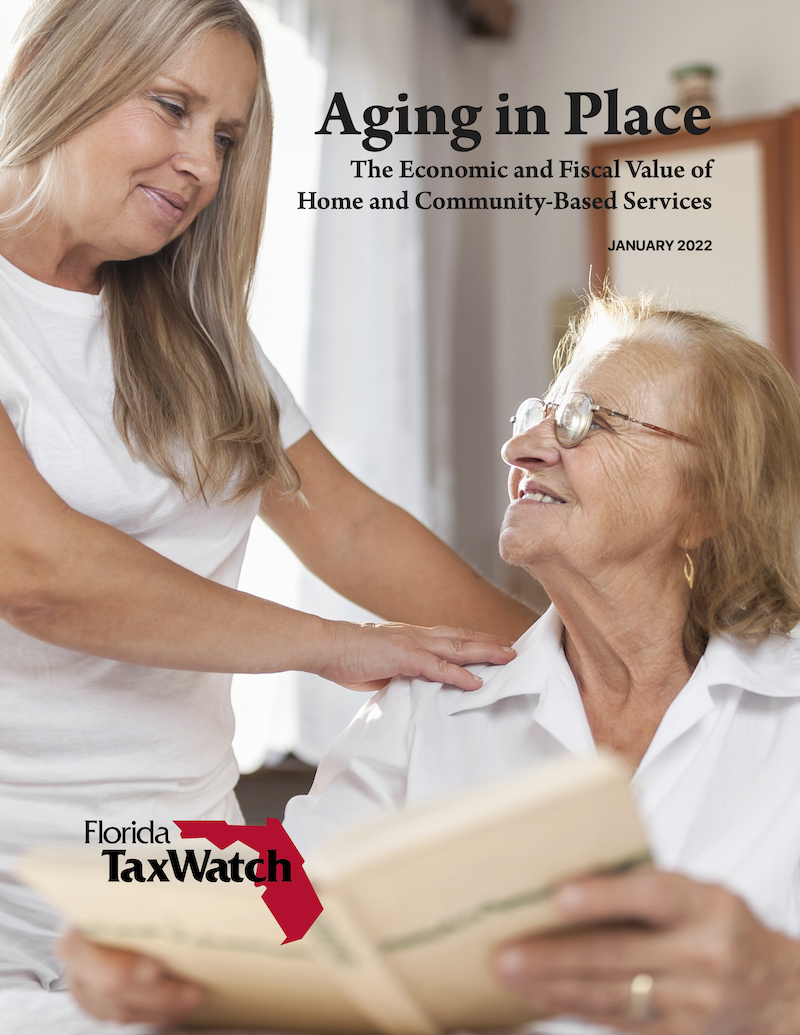Aging in Place—The Economic and Fiscal Value of Home and Community-Based Services
 Similar to demographic trends across the U.S., Florida will encounter a rapid increase in the number of elderly residents requiring long-term care and services. Florida’s 65 and older population is anticipated to grow by 52.1 percent over the next two decades from 4.4 to 6.7 million elderly residents. A variety of continuum of care options exists to accommodate the impending rise in long-term healthcare utilization, ranging from nursing homes to home and community-based settings. Not only do these options differ in their public costs and quality outcomes, but the COVID-19 pandemic has spotlighted the importance of physical risk and exposure to infection when considering what long-term settings exist. Due to the projected growth in Florida’s elderly population over the coming decades, it will be critical to expand resources across the state’s entire continuum of care.
Similar to demographic trends across the U.S., Florida will encounter a rapid increase in the number of elderly residents requiring long-term care and services. Florida’s 65 and older population is anticipated to grow by 52.1 percent over the next two decades from 4.4 to 6.7 million elderly residents. A variety of continuum of care options exists to accommodate the impending rise in long-term healthcare utilization, ranging from nursing homes to home and community-based settings. Not only do these options differ in their public costs and quality outcomes, but the COVID-19 pandemic has spotlighted the importance of physical risk and exposure to infection when considering what long-term settings exist. Due to the projected growth in Florida’s elderly population over the coming decades, it will be critical to expand resources across the state’s entire continuum of care.
Florida TaxWatch analyzed the potential safety benefits, fiscal savings, and quality outcomes from expanding HCBS and found the following:
- Home and community-based settings are a safer alternative to minimize physical risk. Between March and July 2020, only two percent of HCBS residents nationwide contracted COVID-19 compared to nursing homes (37 percent) and assisted living facilities (14 percent).
- When considering actual mortality, death rates among HCBS residents nationwide were less than one percent between March and July 2020, compared to nursing homes (11 percent) and assisted living facilities (five percent).
- The cost of providing care in a home setting rather than in a residential setting would potentially generate more than $745 million in fiscal savings annually, before adjusting for inflation.
- Assuming the current waitlist of Florida’s state-funded HCBS program (e.g., Community Care for the Elderly Program), a one percentage point decrease in the waitlist would generate $63.7 million in cost savings for Florida’s taxpayers.
- Addressing uncompensated care among informal family caregivers could yield more than $30 billion in annual economic benefits by reducing extra medical expenses and foregone earnings.
- Past empirical studies show that individuals who transitioned from institutional to home settings reported significant improvements in quality of life and care. Overall life satisfaction rose 16.9 percentage points in the first year among patients, and satisfaction with care and living arrangements rose by 11.7 and 30.5 percentage points, respectively.
- Among transitioned patients, there was a statistically significant reduction in re-institutionalization within 180 days and a lower risk of hospitalization. Efforts by the federal government to enhance and expand HCBS provision across the nation—primarily through the American Rescue Plan Act (ARPA)—constitute a valuable step in addressing the long-term care needs of the future. Florida is set to receive more than $1.1 billion in enhanced federal funds to develop and/or expand HCBS programs; however, the state’s proposed spending plan does not address the waitlists for elderly populations or uncompensated care among family caregivers. To yield the greatest return on investment for incoming federal funds, and to expand the value of HCBS,
Florida TaxWatch recommends the following to policymakers:
- Expand the use of HCBS by reducing waitlists to state-funded HCBS programs (e.g., the Community Care for the Elderly or Home Care for the Elderly) and by improving access through the Medicaid 1915(b)/1915(c) waiver.
- Identify and standardize quality measures for HCBS that incorporate metrics involving both quality of life and quality of care. Ensure such quality metrics are readily available to families and potential long-term care recipients.
- Conduct empirical studies to measure the direct relationship between HCBS usage and quality outcomes.
- Recognize and support the role that family caregivers serve in providing long-term care to family members. Integrate informal caregiving into any comprehensive plan to improve HCBS usage in Florida.